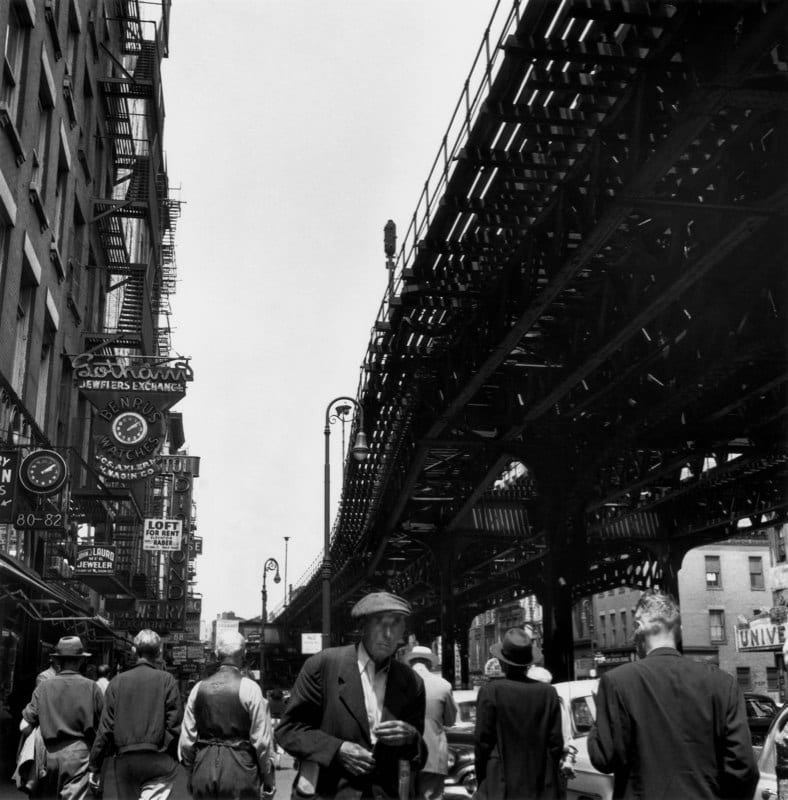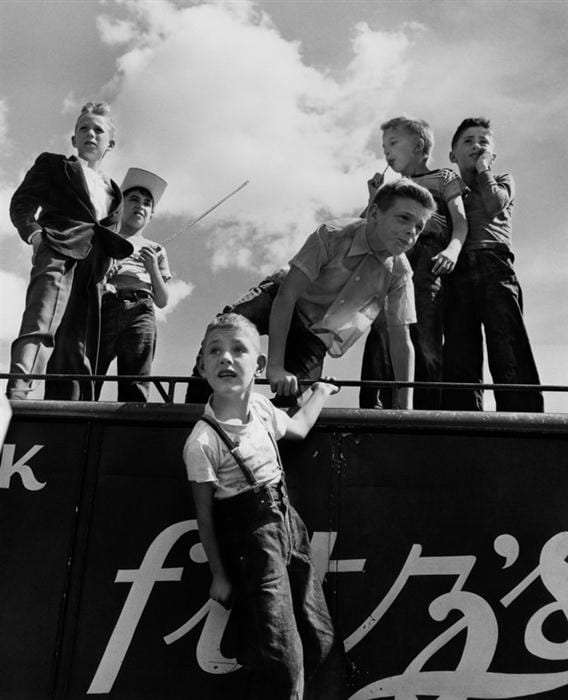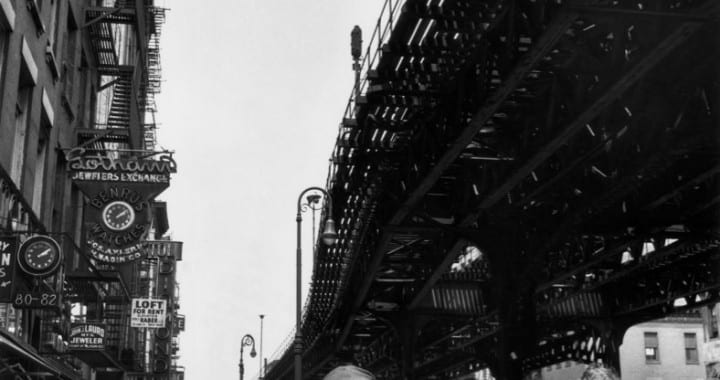
Under the El at the Bowery, New York, c. 1950
By Berenice Abbott, excerpts from Universal Photo Almanac, 1951
The world today has been conditioned, overwhelmingly, to visualize. The picture has almost replaced the word as a means of communication. Tabloids, educational and documentary films, popular movies, magazines, and television surround us. It almost seems that the existence of the word is threatened. The picture is one of the principal mediums of interpretation, and its importance is thus growing ever vaster.
Today the challenge to photographers is great because we are living in a momentous period. History is pushing us to the brink of a realistic age as never before. I believe there is no more creative medium than photography to recreate the world of our living time.
Photography gladly accepts the challenge because it is at home in its element: namely realism – real life – the now. In fact, the photographic medium is standing at its own crossroads of history, possibly at the end of its first major cycle. A decision as to which direction it shall take is necessary, and a new chapter in photography is being made – as indeed many new chapters are now taking the place of many older ones.
The time comes when we progress, must go forward, must grow. Else we wither, decay, die. This is true for photography for every other human activity in this atom age. It is more important than ever to assess and value photography in the contemporary world.

Children at the Fair, Maine, 1967
Let us first say what photography is not. A photograph is not a painting, a poem, a symphony, a dance. It is not just a pretty picture, not an exercise in contortionist techniques and sheer print quality. It is or should be a significant document, a penetrating statement, which can be described in a very simple term – selectivity.
To define selection, one may say that it should be focused on the kind of subject matter which hits you hard with its impact and excites your imagination to the extent that you are forced to take it. Pictures are wasted unless the motive power which impelled you to action is strong and stirring. The motives or points of view are bound to differ with each photographer, and here in lies the important difference which separates one approach from another. Selection of proper picture content comes from a fine union of trained eye and imaginative mind.
To chart a course, one must have a direction. In reality, the eye is not better than the philosophy behind it. The photographer creates, evolves a better, more selective, more acute seeing eye by looking ever more sharply at what is going on in the world. Like every other means of expression, photography, if it is to be utterly honest and direct, should be related to life of the times – the pulse of today. The photograph may be presented as finely and artistically as you will; but to merit serious consideration, must be directly connected with the world we live in.
What we need is a return, on a mounting spiral of historic understanding, to the great tradition of realism. Since ultimately the photograph is a statement, a document of the now, a greater responsibility is put on us. Today, we are confronted with reality on the vastest scale mankind has known. Some people are still unaware that reality contains unparalleled beauties. The fantastic and unexpected, the ever-changing and renewing is nowhere so exemplified as in real life itself. Once we understand this, it exercises a dynamic compulsion on us, and a photo-document is born.
The term ‘documentary’ is sometimes applied in a rather derogatory sense to the type of photography which to me seems logical. To connect the term ‘documentary’ with only the ‘ash-can school’ is so much sheer nonsense, and probably stems from the habit of pigeon-holing and labelling everything like the well-known 57 varieties. Actually, documentary pictures include ever subject in the world – good, bad, indifferent. I have yet to see a fine photograph which is not a good document.
Great photographs have ‘magic’- a reveling word that comes from Steichen. I believe the ‘magic’ photographers are documentarians only in the broadest sense of the word.
According to Webster, anything ‘documentary’ is: ‘that which is taught, evidence, truth, conveying information, authentic judgment.’ Add to that a dash of imagination, take for granted adequate technique to realize the intention, and a photographer’s grasp will eventually equal his reach – as he turns in the right direction at the crossroads.
[nggallery id=370]
ASX CHANNEL: BERENICE ABBOTT
(All rights reserved. Text & Images @ Berenice Abbott Estate)
